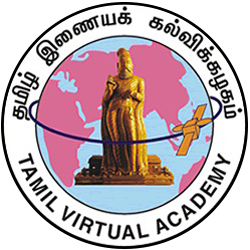Primary tabs
Lesson - 2
C02132 - தன்மை வினை முற்றுகள்
This lesson explains the finite verbs used with I person subjects. தன்மை வினைமுற்றுகள் do not indicate the gender. They are classified into different groups such as explicit (தெரிநிலை வினை முற்றுகள்) and implicit (குறிப்பு வினைமுற்றுகள்).
Inflexional endings carry the I, II or III persons How are finite verbs described in grammar? What is meant by I person singular finite verbs? what is I person plural verbs? what are the ole singular and plural forms of I person. Such questions are dealt with in this lesson.
Word analysis of a finite verb indicates the stem, a connector a tense marker and an inflexional ending for the person and the number. ‘த்‘, ‘கிறு‘, ‘வ்‘ are the past, the present and the future tense markers in Tamil. Gender is not reflected in the first person singular finite verbs.
In ancient Tamil literature these verbs had some more inflectional endings; but they are not in use now.
Such a treatment of finite verbs is the subject in this lesson.

